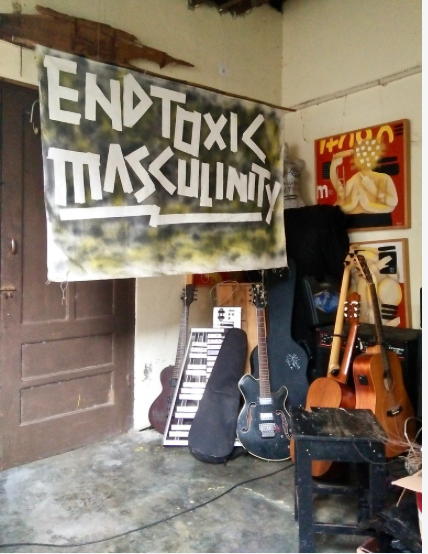Exploring the Toxic in Toxic Masculinity

“End Toxic Masculinity” by labnusantara is licensed under CC BY-NC-ND 2.0
In recent years, a shift has occurred in definitions of “masculinity,” but how much has actually changed?
April 20, 2021
You’re scrolling through Tik Tok, Instagram, or any other social media you might have when all of a sudden a male in a skirt shows up on your timeline. In this scenario, you could find yourself puzzled yet intrigued, shocked yet pleased, or disgusted and uncomfortable.
Society often reacts to men in skirts. However, the topic of toxic masculinity is getting more attention lately. Toxic masculinity is a term that represents the behaviors and perceptions that people often have about what it means to be “a man.” It typically includes physical strength and it often attacks men who dress outside of cisgender norms or who act in a way that could be considered “unmanly” or who those with toxic masculinity find “effeminate.”
While toxic masculinity has been widely accepted for generations, today’s changing social awareness tends to draw attention to its negative impacts.
Since the skyrocketing popularity of TikTok, toxic masculinity has been challenged by a lot of male users on the platform that show who wear skirts, eyeliner, dresses, and other feminine accessories. Gen-Z as a whole is trying to diminish the idea from generations before us that only one gender is only allowed to act, dress, look, or perform a certain way. Toxic masculinity refers to the notion that some people’s idea of “manliness” perpetuates domination, homophobia, and aggression.
Due to society’s narrative on the stereotype of a male, many “men” have had to either hide their true identities from embarrassment, fear of harassment, or just acceptance in general. The idea of “canceling” or “burning” the term and letting people just do whatever they want and be whatever they want has been brewing for some time now.
One Gen-Z member, senior Venz Oberg, defines toxic masculinity as “how society expects men to act. Men can’t be vulnerable or else they fit the stereotype of being gay.” For him, the societal perspective of the role of a “man” is negative.
“We’re all just human beings who should be allowed to express vulnerability which explains why suicide rates are higher for men than women,” Oberg said. He added that he thinks it is okay for men to show emotions and express how they feel. “It’s ok to cry or shed a tear.”
For Oberg, rejecting toxic masculinity requires mindfulness. “It’s all about authenticity and I’ll do whatever I want, listen to whatever music I want to, and express what I feel whenever I want to and allow myself to be more vulnerable because at the end of the day, I’m just a human being and we feel emotions,” said Oberg. “I work on my masculinity with just being more real with myself and not caring about if what I do or get myself into is so masculine or so feminine.”
Vulnerability is a growing issue for those who struggle with toxic masculinity. Those who challenge toxic masculinity often face criticism from society. From Oberg’s perspective, the worst trait about toxic masculinity is “not wanting to express vulnerability and how you really feel.”
Aggression or violence also contributes to the idea of the masculine ideal. The popular saying “boys will be boys” seems to give boys the excuse for careless, aggressive, or damaging behavior while condemning the same behavior from females.
Behavior like that often gets overlooked by people just because boys are being “boys.” These views can cause harm and embellish the idea of masculinity. They can also reenforce the idea of “manliness” that those with toxic masculinity hold.
Society seems to define masculinity as doing manual labor, exercising often, and keeping up a strong perspective on themselves. Oberg said that he feels more manly or masculine when he “works out and actually is true to himself” while feelings of less masculinity converge when he “listens to music made by female artists such as Britney Spears or female bands such as Fifth Harmony.”
Some argue that everyone should be able to express themselves as much as they want to if it makes them happy. People are starting to accept themselves and feel comfortable enough to wear things that would be considered feminine or not manly enough according to society. People can sometimes express signs of femininity without noticing they’re doing it just because it’s how they naturally act.
Stereotypes for gay men would to automatically connect them with a male acting like a female, which is not always the case. Some people are ashamed of their personality and some are not. Oberg is not ashamed of showing more of a softer side and supports males who feel comfortable enough to do the same. “It’s their life. Not all men are bro-ey.”
It’s hard to know if you yourself shows signs or examples of toxic masculinity, for others you already know that you do and embrace it. Oberg explained that people already had ideas or suspicions of him being gay before he even came out. Mentioning that “I’m so honest with my emotions, And also just from the type of music I listen to.”
Overall, the idea of toxic masculinity is slowly but steadily deteriorating, with more and more males becoming more aware of their self worth and becoming more comfortable with themselves in and out of public. Those seeking resources to understand more should visit PFLAG STL.
